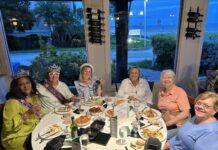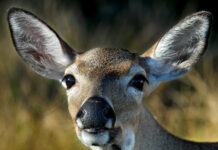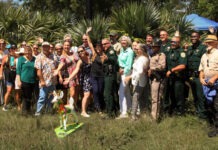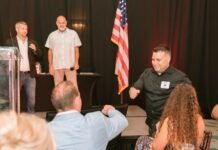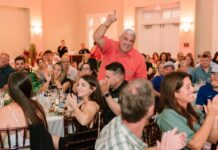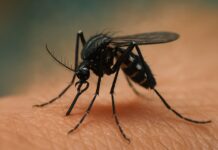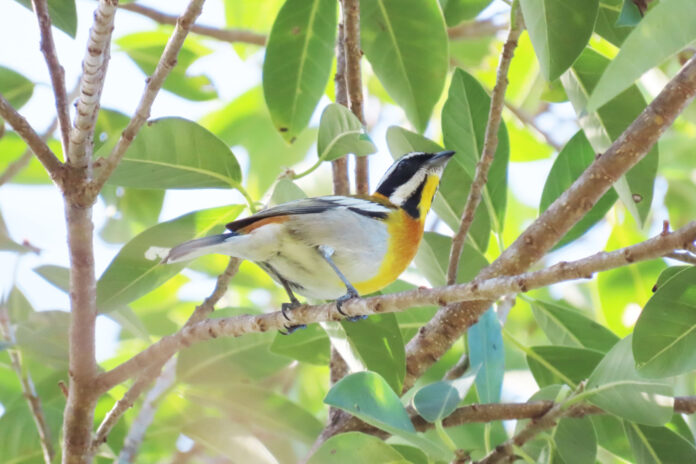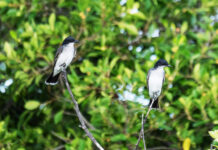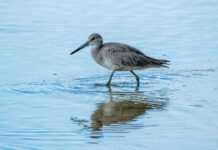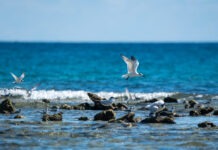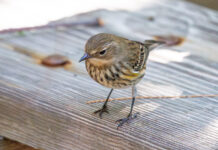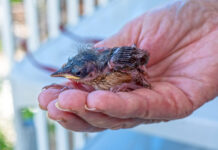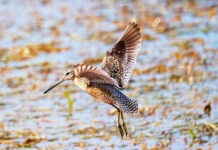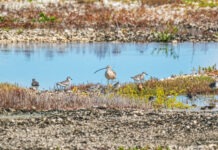I was meeting Kevin Christman to do some birding at the Key West Tropical Forest and Botanical Garden, which I always think of as just the Botanical Garden, but I had to run some errands first and he arrived before me. His first report from the field was a text that said there was an Easter egg hunt on and kids everywhere, but he thought if he got in there, he could probably beat most of them to the eggs.
I thought about it for a second, Kevin being 2 to 3 times taller than most of the more youthful participants, which would give him an advantage in stride length and finding eggs set on top of things. But the kids were much closer to the ground, giving them not only much tighter turning radii, but also limiting how much effort they had to put into stooping down and scooping up the eggs. And they would have an advantage finding the eggs that were hidden under things. Not to mention all the over-protective parents Kevin would have to fight off. And really, aren’t eggs just birds that don’t move? Where’s the challenge in that?
I was driving, but hoping to text him some of these thoughts at the next stop light, when another text from him came through. This one said, “BANANAQUIT!!!”
All thoughts of Easter eggs were vanquished.
Bananaquits are these chattery sugar junkies from Central America, South America and the Caribbean. They are a little bigger than a North America warbler, and huskier in shape, and with a sturdy, long-for-a-songbird, down-curved bill. They have bright yellow breasts and bellies and black heads with thick white eyebrows that are often described in the literature as conspicuous. They feed mostly on fruit and nectar. I’ve seen a few thousand of them in my travels, usually swarming hummingbird feeders for the easy fix. But I hadn’t seen one for a long time, and I’d only ever seen one in the U.S., years ago at Bahia Honda State Park.
I did what I could to get there faster which, in the land of lollygagging golf carts and swerving scooters, was not much. The sides of College Road, when I got there, spilled over with parked cars, making me mutter profanities about parking like a person from up the Keys. Then I ended up getting tips from someone about ducks and where to find them.
Inside, the park was as packed as I’d ever seen it. People were everywhere. Kids were everywhere, wandering and weaving in an anticipatory Easter egg hunt haze. I tried to hurry, but mostly concentrated on not tripping over any of them. As Whitney Houston once said, “I believe that children are the future.” And as my niece has often said to my sister, they’re the ones who will be picking our nursing homes, not to mention running them. Also, they were all pretty cute with their bunny ears and painted faces.
I found Kevin as far out of the fray as he could be, under a fig tree, staring straight up.
“I’ve got a spindalis,” he said.
“No bananaquit?” I asked.
“I’m not sure,” he said.
Kevin had been walking around and heard a bird very softly singing a song he didn’t recognize. So he opened up Merlin and the app told him it was a bananaquit.
Merlin was developed by the folks at the Cornell Lab of Ornithology where you can upload a picture of a bird and the app will tell you what it is, though I’ve never used that option. But you can also hit a button and it will start recording, and it will identify the species of all the bird calls it can hear. I used that option a great deal when I was in Scotland last year and I wasn’t familiar with what I was hearing, and it was pretty spot on.
The thing is, it’s good, but not perfect. It should be taken as presenting a possible ID of a bird, but not a definitive one.
Now it was unclear if there were both a bananaquit and a Western spindalis in the tree, or if a singing spindalis sounds enough like a singing bananaquit to fool Merlin.
By spindalis he meant Western spindalis, a Caribbean rarity that shows up in the Keys once a year or so. There are seven species of Western spindalis, and it has been the belief in the birding world for a long time that they would be split, at some point in the future, into several different species. There are two types that get seen up in South Florida – green-backed and black-backed. Black-backed are more common, and are thought to be from the Bahamian population. A pair even tried to breed in the Everglades a few years ago.
The green-backed are the rare ones. Until last fall, only one green-backed Western spindalis had ever been seen in the U.S. Then last October one was found by a birder named John Groskopf at Fort Zachary Taylor State Park. It hung around for a few days, then disappeared. But on New Year’s Eve I saw one at Indigenous Park. And then in late January I got an email from a visitor named Craig Triplett with a photo of a green-backed spindalis in the Key West Cemetery.
It seemed more likely that this was the same individual bird being seen multiple times, but it was hard to be sure.
The spindalis Kevin and I were now looking at was straight up, in the glare of the sun, so getting a good look at it was pretty uncomfortable, and we were only seeing its face and its belly. But we had two things to figure out. Was it the spindalis that was singing? And did the spindalis have a green back or a black back?
It took a while, but eventually the bird did hop to another branch and change the direction it was facing, and let us see the green on its back. It was probably the same individual that had been seen before.
It was in really great light, though, and almost out in the open, and I raised my camera to take the shot, clicked the shutter button, and got a message on my screen telling me there was no card in the camera. Because I am a professional.
I lowered the camera and let it hang on the strap around my neck like the albatross of photographic incompetence.
A few minutes later we could hear the singing again, and we raised our binoculars to see its throat and its bill moving, meaning it was the spindalis that Kevin had been hearing all along.
Not the rarity we thought it was, but a rarity nonetheless.
We never did get any of those Easter eggs, though.

